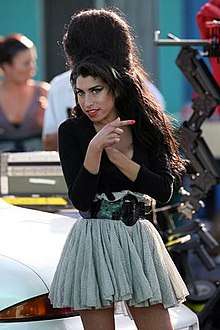Beehive (hairstyle)
The beehive is a hairstyle in which long hair is piled up in a conical shape on the top of the head and slightly backwards pointing, giving some resemblance to the shape of a traditional beehive. It is also known as the B-52 due to a resemblance to the distinctive nose of the Boeing B-52 Strategic Bomber.[1]

Origin
It originated as one of a variety of elaborately teased and lacquered versions of "big hair" that developed from earlier pageboy and bouffant styles. It was developed in 1960 by Margaret Vinci Heldt of Elmhurst, Illinois, owner of the Margaret Vinci Coiffures in downtown Chicago, who won the National Coiffure Championship in 1954, and who had been asked by the editors of Modern Beauty Salon magazine to design a new hairstyle that would reflect the coming decade.[2] She originally modeled it on a fez-like hat that she owned. In recognition of her achievement, Cosmetologists Chicago, a trade association with 60,000 members, created a scholarship in Heldt’s name for creativity in hairdressing.[2] The beehive style was popular throughout the 1960s, particularly in the United States and other Western countries, and remains an enduring symbol of 1960s kitsch.
Despite inventing the hairstyle, Heldt did not name it: for the final touch in her original design she added a bee-shaped hat pin and from that a reporter for the magazine Modern Beauty Shop (now Modern Salon) "it looks just like a beehive! Do you mind if we call it the beehive?"[3]
Heldt died on June 10 2016 at a senior living community near Chicago.[4]
Technique
The beehive is constructed by backcombing or teasing the hair with a comb, creating a tangled pile which is lightly combed over to make a smooth outer surface. The longer the hair, the higher the beehive. Beehive styles of the early 1960s sometimes overlapped with bouffant styles, which also employed teasing to create hair volume; but generally speaking, the beehive effect was a rounded cone piled upwards from the top of the head, while the simple bouffant was a wider, puffier shape covering the ears at the sides. Both of these can be distinguished from the pompadour style, the basic type of which is swept upwards from the forehead.
Notable examples

- The popular girl group, The Ronettes, helped popularize the hairdo. "We came from Spanish Harlem", recalls the group's veteran lead singer, Veronica "Ronnie" Spector, in a Village Voice interview. " 'We had high hair anyway.' So the Ronettes made their hair still higher—'We used a lot of Aqua Net' ".[5]
- The B-52's, a new wave rock band took their name from the hairstyle which was worn by members Cindy Wilson and Kate Pierson.[6]
- Coronation Street character Bet Lynch wore a platinum blonde beehive since the 1970s. The Manchester Evening News dubbed this the "worst haircut in soap history" even while acknowledging that it made her one of the series' most memorable characters.[7]
- Marge Simpson from The Simpsons is a well known fictional character with the hairdo.[8]
- The character Flo, a waitress in the 1974 film Alice Doesn't Live Here Anymore, as well as the subsequent TV series wore her hair in a beehive.
- Sheila Broflovski from South Park wears her hair in a beehive.
- Mari Wilson, British singer probably best known for hit Just What I Always Wanted in the 80's, was well known for her beehive hairstyle throughout that decade.
- Amy Winehouse's beehive was inspired by Ronnie Spector's from the 60's group, the Ronettes. "Ronnie Spector—who, it could be argued, all but invented Winehouse's style in the first place when she took the stage at the Brooklyn Fox Theater with her fellow Ronettes more than 40 years ago—was so taken aback at a picture of Winehouse in the New York Post that she exclaimed, "I don't know her, I never met her, and when I saw that pic, I thought, 'That's me!' But then I found out, no, it's Amy! I didn't have on my glasses."[9]
- Former Arizona governor, Rose Mofford was known for her signature beehive hairdo.[10]
- With regards to the beehive of Janice Rand from Star Trek: The Original Series, Tor.com stated, "When you think of the 60s and science fiction hairstyles, the first image is probably Rand’s beehive hair".[11]
- Patsy Stone from Absolutely Fabulous always wore her blonde hair in a beehive with a fringe, a signature trait of the character.
References
- Weber, Bruce (15 June 2016). "Why We Celebrated the Beehive and Its Maker". The New York Times. Retrieved 6 December 2016.
- Mannion, Annemarie (30 December 2010). "Beehive style lands Elmhurst woman a place in fashion history — Elmhurst news, photos and events —". Triblocal.com. Archived from the original on 8 January 2011. Retrieved 29 February 2012.
- Bruce Weber, Margaret Heldt, Hairdresser Who Built the Beehive, Dies at 98, The New York Times, June 13, 2016, accessed June 14, 2016.
- "Margaret Vinci Heldt, creator of the beehive hairstyle, dies at age 98". The Guardian. 13 June 2016. Retrieved 16 June 2016.
- Yaeger, Lynn (22 May 2007). "Winehouse Rules: Amy channels Ronnie Spector's high hair and Cleopatra eyes". Village Voice. Retrieved 27 July 2011.
- Riggs, Ransom (20 July 2007). "A history of bad hairstyles". CNN. Retrieved 12 August 2016.
- "Hair-raising truth about Coronation Street", Manchester Evening News. Retrieved on 2007-10-30.
- Cochrane, Lauren (24 September 2015). "Krusty the Clown, your key fashion influence for AW15 – stylewatch". The Guardian. Retrieved 23 May 2016.
- Yaeger, Lynn (22 May 2007). Winehouse Rules at the Wayback Machine (archived 6 March 2012). The Village Voice.
- "Rose Mofford, Arizona's first female governor, dies at 94". latimes.com. Los Angeles Times. Associated Press. 15 September 2016. Retrieved 19 October 2018.
- "Cosmic Coiffures: 6 Unforgettable Hairstyles in SFF". Tor.com. 28 April 2011. Retrieved 3 September 2016.
External links

